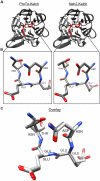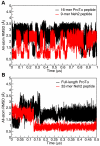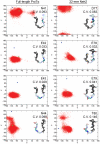Microsecond molecular dynamics simulations of intrinsically disordered proteins involved in the oxidative stress response
- PMID: 22125611
- PMCID: PMC3220680
- DOI: 10.1371/journal.pone.0027371
Microsecond molecular dynamics simulations of intrinsically disordered proteins involved in the oxidative stress response
Abstract
Intrinsically disordered proteins (IDPs) are abundant in cells and have central roles in protein-protein interaction networks. Interactions between the IDP Prothymosin alpha (ProTα) and the Neh2 domain of Nuclear factor erythroid 2-related factor 2 (Nrf2), with a common binding partner, Kelch-like ECH-associated protein 1(Keap1), are essential for regulating cellular response to oxidative stress. Misregulation of this pathway can lead to neurodegenerative diseases, premature aging and cancer. In order to understand the mechanisms these two disordered proteins employ to bind to Keap1, we performed extensive 0.5-1.0 microsecond atomistic molecular dynamics (MD) simulations and isothermal titration calorimetry experiments to investigate the structure/dynamics of free-state ProTα and Neh2 and their thermodynamics of bindings. The results show that in their free states, both ProTα and Neh2 have propensities to form bound-state-like β-turn structures but to different extents. We also found that, for both proteins, residues outside the Keap1-binding motifs may play important roles in stabilizing the bound-state-like structures. Based on our findings, we propose that the binding of disordered ProTα and Neh2 to Keap1 occurs synergistically via preformed structural elements (PSEs) and coupled folding and binding, with a heavy bias towards PSEs, particularly for Neh2. Our results provide insights into the molecular mechanisms Neh2 and ProTα bind to Keap1, information that is useful for developing therapeutics to enhance the oxidative stress response.
Conflict of interest statement
Figures






References
-
- Dyson HJ, Wright PE. Intrinsically unstructured proteins and their functions. Nat Rev Mol Cell Biol. 2005;6:197–208. - PubMed
-
- Dunker AK, Lawson JD, Brown CJ, Williams RM, Romero P, et al. Intrinsically disordered protein. J Mol Graph Model. 2001;19:26–59. - PubMed
-
- Wright PE, Dyson HJ. Intrinsically unstructured proteins: re-assessing the protein structure-function paradigm. J Mol Biol. 1999;293:321–331. - PubMed
-
- Dunker AK, Garner E, Guilliot S, Romero P, Albrecht K, et al. Pac Symp Biocomput; 1998. Protein disorder and the evolution of molecular recognition: theory, predictions and observations. pp. 473–484. - PubMed
Publication types
MeSH terms
Substances
Grants and funding
LinkOut - more resources
Full Text Sources
Molecular Biology Databases
Research Materials

